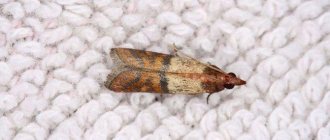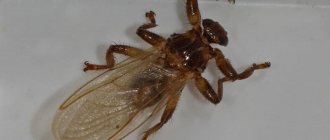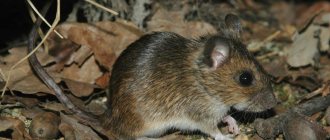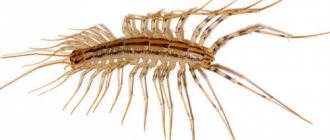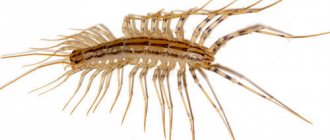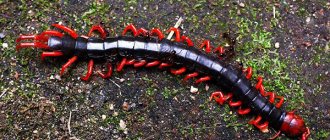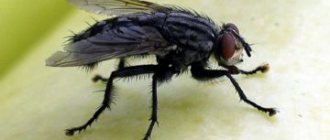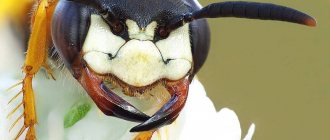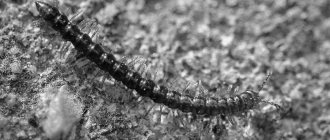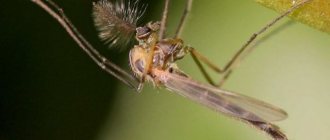The scary and menacing appearance of the mole cricket multiplies rumors and misconceptions. It can be assumed that this insect must bite painfully. But in fact, the cabbage weed physically cannot bite anyone. The structure of its mouthparts is such that it is not able to bite through human skin: nature has ideally adapted this insect for digging underground passages and absorbing plant food. It lacks a sting and glands that produce poison. Let's leave the aesthetic side alone, because some people even like spiders and cockroaches. But the bear still gives some unpleasant sensations to those who grab it with an unprotected hand.
Ways to deal with mole crickets
There are many ways to deal with mole crickets, but you won’t be able to get rid of it quickly. First you need to try traditional methods, only after that turn to chemicals. The video will help in the fight against such insects; mole crickets are difficult to remove, so gardeners share methods. It should be taken into account that methods that are effective in one area may not produce results in another.
Traditional methods of getting rid of insects
- Frequently loosen and dig up the soil; if nests are found, destroy them and cover them with washing powder. In this way, you can destroy several hundred of them, but it is unlikely that you will be able to overcome them completely.
- In the summer, it is necessary to dig out small furrows and instill poison there. If the insects get to these places, they will be poisoned, but there is no guarantee.
- Many gardeners use a simple but effective method: in the fall, dig a small hole and bury manure in it, and when frost sets in, prepare a chemical poison, dig a ditch and fill it. With the onset of cold weather, all the mole crickets will gather in this warm place.
- By spring, you can collect eggshells, grind them into powder and sprinkle the resulting substance into each hole before planting. You need to know what the mole cricket insect eats, and accordingly, add it there.
- Pouring a soap solution into the burrows also has a good effect. Insects and their larvae quickly die from soap. Then you will need to collect all the nests with a shovel and take them away from the garden. If you miss even one nest or fail to destroy the female, the mole cricket will again take over your area. But remember that soap or washing powder can harm not only insects, but also the plants you grow.
- Some people practice planting crops with a pungent odor around the perimeter of the site and between beds of other crops. It could be garlic, mint, wormwood. Spicy-smelling leftover food products are also laid out: herring tails, spiced sprat, herring. But the effectiveness of this method is questionable, because this way you will scare away the mole cricket, but perhaps attract other pests, insects or animals.
If folk remedies do not help, then you need to use chemical ones, but such a struggle will be long. The most effective are “Antonem-F” and “Nemobakt”, which can get rid of 90% of adults and 80% of larvae.
One can talk for a long time about the benefits and harms of the mole cricket; on the one hand, it destroys the crop, and on the other, it fights other harmful insects. But getting rid of this insect is extremely difficult, and this is a fact.
When there really is danger
A mole cricket can be dangerous not only for agricultural and other plants only in cases where it eats poison, remains on the surface of the ground and someone feasts on it. It could be a starling or another bird, a mole, or an overly curious dog with a habit of grabbing everything in its mouth. These same living creatures can grab not only the cabbage plant, but also the poison itself, if the poisonous bait has attracted their attention. Then manifestations of intoxication are all the more possible.
If you have not taken care of your pet, you need to take it to the veterinary clinic as soon as possible. It is quite possible that the culprit is not a mole cricket, but, for example, a poisoned mouse or rat. Then the danger is really serious, since coumarins, substances that prevent blood clotting, are used to bait rodents.
A gardener who tinkers in the ground should not be afraid of a mole cricket bite, but of other much more serious threats. It is impossible to suffer from the poison of the cabbage plant - it has no poisonous glands. But if you treat your area with pesticides without following safety precautions, you can easily get poisoned. And if on the same day you picked up a bear in your hand, you can link this with your poor health.
The greatest danger lies in the ground. The soil can harbor the causative agent of tetanus and other dangerous diseases. Therefore, a person who constantly works on a plot of land and comes into contact with organic fertilizers (compost, manure) must be vaccinated against tetanus. With the slightest damage to the skin, tetanus toxin enters the bloodstream and begins to affect the nervous system. If the ingestion of the tetanus bacillus coincides with the capture of a mole cricket, a person may subsequently not pay due attention to his condition. And for tetanus, the sooner the vaccine (tetanus toxoid) is administered, the more favorable the patient’s prognosis.
Life cycle
In spring, the female burrows into the soil to a depth of 30 cm and lays 100–350 eggs in an underground chamber. After mating, it may take one or two weeks before she begins to lay eggs.
They undergo incomplete metamorphosis. The eggs hatch in ten to twenty days. She guards them for another two to three weeks. Nymphs molt six times. As the nymphs grow, they consume large amounts of plant material underground.
It takes one to three years to reach maturity. Adults and nymphs live underground throughout the year in tunnel systems that can reach depths of over a meter in winter.
Adults can move up to 8 km during the breeding season. The entire life cycle lasts 1-3 years depending on climatic conditions.
Adult and late larvae overwinter underground at a depth of about 1 m. Mass emergence after wintering occurs when the temperature rises to 12-15 ° C.
Feeding and maintaining mole crickets at home
Any classification of flora and fauna into harmful and beneficial inhabitants is conditional and subjective.
Some people breed mole crickets in their gardens for the purpose of selling them as a folk remedy; others simply keep them as a funny little “little animal” in a box at home. In captivity, the cabbage butterfly is extremely reluctant to eat vegetables; it does not like potatoes, cucumbers, apples or strawberries - something that amateur gardeners accuse it of eating.
So what does a mole cricket eat? They feed her:
- finely chopped meat scraps,
- crushed by insects,
- gammarus (a small crustacean used as fish food),
- as well as porridges made from medium-sized grains.
Mole crickets especially love rolled oat porridge and boiled oatmeal, and eat sprouted grains.
It is important to know!
- You should not give them rotten meat and fish - mole crickets cannot stand strong and unpleasant odors!
- They do not place a container of water, but moisten (without flooding) the soil in which the mole cricket is kept, since it prefers to live in soft, moist soil rich in humus.
- Food is placed in the hole or nearby: these insects are very active and dig many holes, periodically changing entrances and exits.
Their lifespan is about 5 years: 2-3 years the larva develops into an adult, and they can live 1-2 years as adults, depending on favorable conditions.
Where did the name “bear” come from?
Mole crickets got their name for their large size, brownish-brown color, massive clawed front paws and pubescent body, which makes it possible to compare this insect with a bear. There are several popular names for these insects: cabbage grass, mole cricket or cricket mole, earthen crayfish, top.
The animal is called a cabbage plant for its love of young cabbage seedlings. The Latin name of the mole cricket from the genus Gryllotalpa sounds like “mole cricket”. This is confirmed by the similarity with a cricket in the structure of the body and the ability to make sounds. The mole cricket resembles a mole with its widened front paws and the ability to burrow into the ground. The front part of the insect resembles a crayfish: the structure of the head, shell, mustache and paws, somewhat similar to claws. The mole cricket is called a top because of the sharp claws on its front paws, reminiscent of wolf teeth.
Anatomical structure
The mole cricket is one of the pests in gardens and vegetable gardens. It is also called cabbage, top, earthen crustacean. The habitat of the mole cricket is manured and humus-rich gardens, greenhouses, next to ponds and fields with cereals. Often the mole cricket appears at night, in rare cases it is visible during the day.
Externally, the insect is large in size, it has an elongated body of a yellowish-green hue with golden-brown markings. The belly of the individual is olive-yellow, short leathery transparent wings with many veins. The wings, when folded, extend their veins beyond the body. The mole cricket has 6 legs, they are short and powerful in front, they have spines, with which she digs. Therefore, the question often arises whether mole crickets bite.
Many people believe that it should not be picked up by hand, since a mole cricket bite can have a negative impact on health.
- The temperature will rise.
- A gag reflex will appear.
- A headache will occur.
- The human body will be weakened.
- Other signs appearing due to a deadly toxic substance entering the bloodstream.
insect anatomy
But anyone who believes that the mole cricket is poisonous and will bite is mistaken. The insect is not capable of biting or piercing human skin. Painful sensations are experienced from its front paws, which have characteristic pointed teeth. Thanks to the teeth, the root crop pest digs into the soil, affecting the root structure. At the same time, the claws and mouthparts are not endowed with powerful muscles that can damage the skin, which refutes the fact that the crustacean bites.
When the top sits in your arms out of fear of danger, it tries to free itself by any means. Biting, pinching his enemy with his paws, he leans against his hand. If pain occurs as a result, most people believe that the insect will bite.
Therefore, whether an individual can bite or not, the answer is negative.
What danger does mole cricket pose to the garden?
Having moved into my house from a rented apartment, I happily began cultivating a vegetable garden. Planting onions and sowing carrots made me happy, I was already looking forward to the finished harvest. I decided to sow carrots not like my mother, by the handful, but in a different way, to increase the yield. I took paper tape, spread it with starch paste, then glued the seeds at a distance of 0.5 cm. I sprinkled the tape with only a little earth. And I was incredibly surprised to see a week later that the earth along the entire length of the belt had been dug up.
My surprise knew no bounds; I had never seen anything like this before. It turns out that the mole cricket happily ate the sprouted carrots and snacked on the starch paste! This individual eats everything, bites off the roots of young cucumbers and especially loves young shoots of watermelons, practically dragging them into holes with it.
After the insect, only the flaccid remains of the once living shoot remain.
Yes! Burrows! This insect also digs huge tunnels that collapse, collapsing the garden bed as soon as you start watering the soil. As a result, in the first year, half of what the mole cricket did not have time to eat was dug up and collapsed, and grew small, and even clumsy.
Description of the larva
The mole cricket larva can slightly resemble crickets or six-legged spiders with an elongated body. Their size can reach 15 mm. The front legs of the larva are turned outward; the larva works with them, raking the earth in front of itself.
The cabbage larva resembles adult insects in appearance, with the difference that it is much smaller in size. During its active development, the insect larva molts five times, after which it matures and becomes quite ready for further reproduction.
The larvae are not able to fully develop in the summer, so they remain over the winter. Some of the already adult insects overwinter with them.
The mole cricket is not particularly resistant to cold conditions, so in harsh winters some of the insects may die. How much fat the insect has accumulated will determine its survival during the winter days, as well as subsequent fertility.
In this photo you can see what a mole cricket larvae looks like:
Many people ask questions: is the mole cricket a poisonous insect or not? Despite its terrifying appearance, the insect is not dangerous to humans, but nevertheless causes a lot of harm to gardeners and their crops. There are many both folk and modern ways to destroy it.
Natural enemies
The fight against orthopteran insects should not come at the expense of the ecological situation in the cultivated area. An effective way to limit the spread of pests is to attract natural enemies.
Repellent plants
Some natural odors drive the mole cricket out of the area. Experienced gardeners plant in the cultivated area:
- Marigold. The persistent aroma of this variety of aster is pleasant to humans, but has a deterrent effect on orthopteran garden pests.
- Calendula. The medicinal plant, with its presence, ennobles the cultivated area and expels the mole cricket from it.
- Chrysanthemum. The sharp, rich aroma of an elegant flower forces the pest to leave the area. Chrysanthemum bushes are planted next to vegetable plants.
- Coniferous trees. Fir branches are laid out between the beds and along their perimeter. To preserve the aromatic properties for a long time, spruce branches are sprinkled with earth. Conifer needles are inserted into the holes with seeds. Harmful orthopteran insects cannot tolerate the fragrant aroma that is pleasant to humans.
- Aspen. Stakes are prepared with a diameter of 2–4 cm and a length of 25–30. Hammered into the ground in places where the pest lives. Aspen branches laid out on beds with vegetable plants are suitable.
Bark is not removed from wood material. It stores a scent that repels insects.
Birds
Mole crickets are part of the typical diet of some birds. The following are attracted to the cultivated area:
- Skvortsov. Birds actively destroy pests, and not only orthopteran beetles.
- Crow. Mole crickets are among the insects they eat. A pair of crows will reliably protect the area from invasion.
- Rooks. With their powerful beak they extract pests and their larvae from the soil. Rooks are smart birds. They love to follow agricultural machinery, collecting insects in the loosened soil.
- Storks. They hunt various field pests. Mole crickets are part of the diet of storks.
Attracting these birds to the cultivated area will significantly reduce the pest population.
Animals
Insectivorous mammals and amphibians are another environmentally friendly way to control garden pests. They feed on mole crickets:
- Jerzy. Orthoptera beetles are an important component of the diet of spiny creatures. Their energy will be a good assistant in the fight against pests.
- Shrews. Exterminating insects, they greatly dig up the soil. Therefore, in the country house or in the garden it is better to limit their vigorous activity.
- Scolopendra. The armored arthropod is a natural enemy of the mole cricket. Centipedes lead a predatory lifestyle. They feed on small invertebrates and insects, including Orthoptera. The bite sometimes causes an allergic reaction in people. Therefore, it is better not to breed them in large quantities on the site.
- Lizards. The quick creature destroys insects with incredible speed. A good assistant in the fight against gardening and field pests. It is easy to attract to areas located on the shores of water bodies or in wetlands.
It is best to lure birds and hedgehogs to the cultivated area. These creatures are widespread and unpretentious to their living conditions.
What crops are affected by the pest?
The pest is a polyphage - an omnivorous insect. Threatens grain, fodder, vegetable plants, berries and ornamental crops. In spring, it is dangerous for young shoots, seedlings, and seedlings of herbaceous plants. The mole cricket destroys sown grains and sprouted seeds. The roots of mature trees and shrubs are too tough for her.
Among vegetables, it often damages tomatoes, eggplants, peppers, cucumbers, carrots, beets, corn, peas, potatoes, cabbage, zucchini, onions, and lettuce. Among berry crops he likes strawberries and grapes. It can eat ripe strawberries, gnaw ripe pears, apples, and plums that have fallen to the ground. The pest finds this prey by crawling out of its burrows at night. The mole cricket is not a vegetarian; it can eat earthworms, other soil inhabitants and insects, including harmful ones.
Reproduction of mole crickets
After a long winter, when the ground warms up well and the air temperature does not drop below +10 degrees, sexually mature individuals crawl to the surface en masse, looking for a mate for mating. The process itself takes place underground and, upon completion, the female begins to arrange a place where she will lay eggs. Around the roots of plants, the insect digs several tunnels, where it arranges small rounded nests, which are 8-10 cm wide. Both parents are engaged in construction, then the female lays from 300 to 500 eggs.
Next, the most crucial period begins, because in order for the offspring to be viable, they need the creation of certain conditions. The female is always close to the clutch; she not only protects the future offspring, but also maintains the necessary humidity and temperature.
The timing of the appearance of the larvae depends on how well the soil has warmed up; approximately two weeks should pass, and then gray nymphs will appear. They do not yet have wings and will remain in their burrow near their mother for about a month. After the offspring becomes independent, the female dies, and the larvae will develop for several more years until they fully mature. During this period they will shed 8-10 times.
Pesticides that kill pests
Medvetox - the name indicates what insects the drug is intended to combat. The granular product, which has a high level of toxicity, has an attractive odor for beetles. A mole cricket only needs to taste the chemical to die.
Rubit is an effective remedy that is convenient to use, since it does not cause harm to humans, and the granules have a bright color. They are poured into passages dug by mole crickets.
Grizzly - also available in the form of granules that have a neutral color. Quite a toxic substance, it is better to work with it with gloves.
Bankol - this drug acts in a special way. The mole cricket becomes paralyzed, cannot move and dies from hunger. The product is safe for people.
Phenoxin Plus – mole crickets and other pests like its smell and taste. A few granules sprinkled into the tunnel dug by the insect are enough to get rid of the problem forever.
Boverin is a new and well-proven remedy. It is harmless to people, animals and beneficial insects. But mole crickets die from it.
Bear bug - this pesticide is used in the form of a solution. It has no harmful effect on plants and people, but it allows you to get rid of mole crickets.
Thunder - used in small portions. 1-2 granules are enough to kill insects
People should work with this product carefully, it is toxic. Typically, gardeners resort to pesticides if traditional means of combating mole crickets have not proven themselves
And it is right. To begin with, you should try the simplest techniques, and only then, if necessary, take on the “heavy artillery”. This will give you a better chance of growing an environmentally friendly crop.
Typically, gardeners resort to pesticides if traditional means of combating mole crickets do not justify themselves. And it is right. To begin with, you should try the simplest techniques, and only then, if necessary, take on the “heavy artillery”. This will give you a better chance of growing an environmentally friendly crop.
These insects simply adore hot, sun-warmed earth. If you mulch the beds with sawdust - mole crickets will like this option much less - they will move to where it is warmer. In addition to marigolds, mole crickets also do not like some other plants. These include garlic, parsley, cilantro, and flowers - calendula and chrysanthemums. The more of the above plants on the site, the higher the likelihood that mole crickets will not appear on it. Seedlings that the gardener especially values - for example, expensive varieties of tomatoes - can be planted in the garden directly in plastic bottles with the bottom cut off.
Seeing this insect for the first time, summer residents, especially women, may be scared - will it bite them? But the most that a mole cricket can do is lightly scratch human skin with its claws. Its jaws are simply not designed to bite.
Sometimes in areas, when favorable conditions are created, mole crickets can grow up to 12-15 cm.
If the sounds that a mole cricket makes (a song) are recorded on a voice recorder and turned on at night at your dacha, other insects may rush to the source of the sound.
A mole cricket can live up to 3.5 years.
Thus, knowing what this insect is and what means you can fight it with, you have every chance of getting rid of mole crickets at your dacha forever.
Although there are a large number of ways to combat mole crickets, the destruction of this pest can take several years. It turns out that in order to completely get rid of this insect you need to take comprehensive measures throughout the year. In this article we will tell you how to deal with mole crickets
during the autumn period.
Harmful activities of insects
https://www.youtube.com/watch?v=https:yd3dlQfecOY
Every gardener knows how the spinning top threatens green spaces. Its harm is predetermined by the principles of nutrition, actions, life cycle, but not the fact that it bites.
harm to the mole cricket
The preferred habitat is underground at a depth of up to 0.5 m, where the crustacean digs winding passages and burrows. Because of this, damage to the roots of crops occurs, which leads to their withering and disease.
Cabbage is used for subsistence both as root crops with roots present in the soil, and as above-ground components of plants. The crustacean's favorite delicacy is cabbage with onions. The larvae of the individual spoil potatoes, carrots, cucumbers and eggplants. Bulbous flowers, trees and bushes often disappear from the attack of the crustacean. All this prevents green crops from growing, and sometimes leads to their death.
Methods of getting rid of the pest.
- A fishing pit is made in the fall by pouring manure into the pit to a depth of up to 80 m of manure. In winter, the fertilizer is thrown away and any parasites found are destroyed.
- If it is necessary to preserve plants in the garden, cut pieces of natural fabric measuring 20x10 cm, moisten them in water and tie the bases of the stems before planting them in the soil.
- The aroma of chicken droppings is unpleasant to these parasites. Make a water infusion with natural fertilizer and water the plants from time to time.
- When trying to get rid of cabbage grass, summer residents tear up their tunnels and pour poison or washing powder into them.
- Also, when a mole cricket is detected, you should use bait using boiled corn, wheat, adding vegetable oil, and an insecticide.
- Every couple of meters they stick an alder tree into a bud and replace it with new branches over time.
insect elimination
The mole cricket feeds on roots, ground parts of plants, and root crops that are in the ground. In the garden it poses a danger to almost all crops.
Cabbage is used for subsistence both as root crops with roots present in the soil, and as above-ground components of plants. The crustacean's favorite delicacy is cabbage with onions. The larvae of the individual spoil potatoes, carrots, cucumbers and eggplants. Often, bulbous flowers, trees and bushes disappear from the attack of the earthen crustacean. All this prevents green crops from growing, and sometimes leads to their death.
It seems that many Hollywood monsters were inspired by the mole cricket insect.
And it is not surprising, because this relative of the ordinary house cricket, even in its natural size, terrifies many summer residents and gardeners, and even more so when enlarged and embellished by workers in the film industry.
The only people who rejoice at this garden monster are the fishermen. They say that catfish take well on mole crickets.
Is Medvedka not a space monster from a horror movie?
Signs of a pest appearing on the site
It is not so easy to see the underground inhabitant, since the mole cricket comes to the surface mainly at night. But its presence on the site reveals a number of signs:
- holes in the soil surrounded by earth (exits of mole cricket burrows to the surface);
- bitten plant stems;
- damaged tubers or root vegetables (bite marks, gnawed areas are visible);
- drying and yellowing of shoots for no apparent reason;
- plants are easily pulled out of the ground.
Also at night you can hear mole crickets (males) singing, making loud chirping sounds. Insects move into the garden from manure heaps and neighboring areas. Typically, “settlement” occurs in the spring, when adults are looking for suitable places to live, mate, and build nests with clutches.
Benefit
You can benefit from the harmful activities of insects. It loosens the soil like a mole, saturates it with some important components that fall into the soil with its excrement. And if you grow cultivated plants in such an area, the presence of mole crickets does not interfere at all.
Interesting!
According to ancient folk recipes, mole cricket helps to cope with tuberculosis. To do this, you need to grind the insect into powder, mix it with a glass of water, and drink it. In some countries, garden pests are used to prepare delicious dishes and serve them in restaurants. Fans of exotic animals breed insects in a terrarium. They reproduce faster They reproduce faster than Madagascar cockroaches.
To the question of whether mole crickets bite, there is a clear answer - no! The insect does not threaten human life; the most it can do is pinch with its forelimbs, even if it is caught in a trap and is trying to be pulled out. This won't cause much discomfort.
- nature in all its manifestations
This article contains answers to various questions about mole crickets.
Does a mole cricket bite or not?
The appearance of this insect can really frighten an unprepared person. The front legs of this beetle, which look like unique strong and developed “paws,” may cause particular concern. These “paws” have pointed teeth, with the help of which the mole cricket bites into the ground and root system of plants.
With these teeth, the mole cricket can scratch human skin. However, the mole cricket cannot bite either with its mouthparts or with its “paws”, since it does not have strong enough “muscles” for this. So the answer to the question of whether a mole cricket bites is definitely negative.
What is the largest mole cricket?
Unfortunately, there are no official institutions, like the Guinness Book of Records, that would document the maximum size and weight of mole crickets.
At the same time, gardeners claim that they have seen giant mole crickets up to 12-15 cm in size and several centimeters thick. Theoretically, this is quite possible.
A mole cricket can grow to such a size if there are very good living conditions - an optimal level of soil moisture, mild winter frosts and a varied diet.
Does the bear fly or not?
Yes, the bear flies. In May, the most romantic period in the life of mole crickets begins - the mating period. Young mole crickets remember that they have wings, which they do not need at all the rest of the time, and at night they fly off in search of a mate.
People, with their inherent cunning, take advantage of the love blindness of mole crickets: at night they put out lanterns, and under them there are troughs with a mixture of water and kerosene. Like all nocturnal insects, mole crickets fly into the light, hit a lantern, fall into a trough and die.
Can a bear sing?
Oddly enough, the answer to this question is yes. During the mating season, mole crickets show similarities with their cricket relatives; they begin to chirp in order to attract a partner. Like crickets, mole crickets' wings serve as musical instruments. On one wing there is a “bow”, on the other there are “strings”. Rubbing one wing against the other, the mole cricket makes sounds that are called the “mole cricket song.”
However, the sounds of this song evoke a completely unsentimental mood among gardeners. Hearing her, they grab a shovel and run to dig up the mole cricket, guided by its song as a guiding thread.
In 1976, American scientists conducted an interesting experiment. The bear's calling song was recorded on a tape recorder. When this recording was turned on at night, it attracted a considerable number of female mole crickets. However, it is unknown what continuation this experience received.
How long does a bear live?
In nature, in one and a half to two years, the mole cricket larva grows into an adult, which, in turn, exists for about one year. If a mole cricket is grown purposefully with the creation of the necessary conditions, then such an adult insect can live for 2-3 years.
Thus, the full life cycle of a mole cricket in the natural environment is relatively short - 2.5 - 3.5 years.
Prevention measures
You can protect your garden in the fall if you take this problem seriously.
- Mole cricket nests are located at a depth of 5 to 50 cm from the soil surface. In the fall, you need to dig the bed to approximately this depth. The passages and nests are destroyed, the eggs end up on the surface, and the larvae die. Repeat the procedure in the spring before planting.
- To prevent mole crickets from eating garden crops, you need to scatter manure over the plot of land in the fall. Over the winter, the mole cricket eggs that she likes to lay there will die.
- Dig a hole near the plot of land and cover it with plastic film. Throw manure there. Closer to autumn, mole crickets will begin to hide there and build a shelter for wintering. With the onset of persistent cold weather, dig up a pile of manure. Eggs, larvae, and adults will die because they will not be able to dig through the frozen ground.
You can reduce the number of mole crickets in your garden. Dig a small hole and dig in the bottle at an angle. They pour some beer. Cover the hole with plywood or a piece of linoleum. About 12 individuals are caught in one bottle. If there is a lantern in the garden, leave it on overnight and place a bucket of soapy water under it. The mole crickets fly towards the light, hit the lantern, and fall into the water.
To protect seedlings and seeds in the garden from pests, you need to deal with the entire plot of land, and not a separate bed.
Before the new planting season begins, it’s a good idea to talk about who is eating the cucumber seedlings in the greenhouse. Not only we humans enjoy eating crispy cucumbers; rodents, insects, and worms love to feast on this plant. You can lose all your seedlings in one night and not know who did it.
Greenhouse owners will agree that the main pests of cucumbers that affect adult plants and seedlings are whiteflies, wireworms, mole crickets, slugs, and fall armyworm caterpillars.
How to protect cucumbers from mole crickets
Cucumbers suffer from mole crickets both in open ground and in greenhouses. The pest is especially widespread in central Russia. It is possible that you have a mole cricket if cucumber seedlings or already grown plants dry out.
Sexually mature individuals - adults - overwinter deep in the ground. In early spring, pests wake up and lay eggs in their nests. There can be up to 500 of them in one clutch. Adults and their larvae damage the roots of cucumbers. They are attracted to cucumber beds with seedlings by moist, loose soil; pests make many moves in the ground. During the day, the pest sits in holes, and at night it eats the roots of cucumber seedlings.
To prevent the mole cricket from eating the seedlings, traps are made from manure. Fresh manure is the favorite delicacy of this pest. Trap pits measuring 50 by 50 cm are dug in the fall and filled with cow manure. When the temperature reaches below zero, the manure is taken out and scattered on the ground. The mole crickets are sleeping at this time, so they do not move and freeze.
You can protect newly planted cucumbers from pests with kerosene. To repel the pest, piles of branches or boards are laid out around the ridge and generously watered with kerosene. The mole cricket moves away from the fragrant beds. For those who prefer chemicals to protect seedlings, insecticides are suitable: “Thunder”, “Phenaxin”, “Grizzly”. Baits are prepared from them.
Medvedka: 120 photos, properties, benefits and harm. Lifestyle and habitat
An individual from the mole cricket family, arthropods, the cricket superfamily, which has straight wings and long mustaches, is popularly called a cabbage mole cricket, or a mole cricket.
origin of name
These insects became bearers of the title “mole crickets” for their large size, dark brown color, powerful front legs, and slightly downy body.
The second name of the individual is cabbage, attached due to its great love for the roots of young cabbage. Such a bug is also called a cricket - mole (translated from Latin), and for good reason - because the bug with its body structure fully resembles a cricket, it even creates a corresponding sound.
The name “mole” is also natural and quite logical - it is the front legs that help it easily overcome soil layers in search of the required food.
Also, a less common name is “top” - this name justifies its structure of the front legs. After all, they have sharp ends, slightly reminiscent of the sharp fangs of a wolf.
Basic outlines of an arthropod
The description of the mole cricket says that it is a rather small insect. The dimensions of its body can reach 50 millimeters and a thickness of 15 millimeters. The upper part of the shell is brown, the lower part is slightly yellowish. At the same time, the entire body, right down to the paws, is covered with fine fluff.
Note!
Having looked at the photo of the mole cricket, the mouth jaws are clearly visible, having additional tentacles on the sides, directed forward. The eyes have a facet structure, located on the sides of the head, and are of medium size, but it is impossible not to notice them.
There are also thin antennae on the head, the size of which is much shorter than that of crickets. The insect has 2 pairs of wings (short and long), 3 pairs of legs. The individual's auditory apparatus is located on the front pair of paws (as in other chirping Orthoptera).
Insect diet
The mole cricket is very fond of many vegetables, berries, other edible fruits, and roots. In addition to the plant menu, they eat earthworms, small beetles, dragonflies, ladybugs and other small inhabitants of the earth.
Top's place of residence
The mole cricket insect is distributed throughout Europe (with the exception of Norway and Finland). In our country, this individual can be found everywhere except the northern parts of the great country.
The main habitat of the insect is in underground passages. They are very fond of places where groundwater branches pass very close to the surface of the earth.
The daily bustle of an individual
Having previously examined the part about what a mole cricket looks like, we can say that the individual prefers to lead its lifestyle away from human eyes, namely in the upper layers of the soil.
With daily labor, these insects make trenches in the ground, eating everything in their path. At night, the mole cricket crawls out to the surface of the earth, trying to remain unnoticed.
Offspring
Reproduction of the species occurs in the spring, when the sun warms up the frozen soil quite well. Mating occurs in a favorite environment underground, after which the mole cricket larva soon emerges.
At one time, the female lays from 300 to 600 eggs, resembling millet grains (oval, yellowish-gray, 2 mm in size). The offspring hatch on average after 15 days, then, under the full care of the mother, they live in the nest for about another month.
After this period, the female freezes and dies. The larvae crawl in different directions, beginning their independent life. They dig grooves, get their own food, and develop within normal limits.
Wintering of insects
Naturally, adult (and not completely) individuals overwinter in soil balls of earth, humus or manure heaps. Going 60-120 centimeters deep, insects survive the cold season well.
With the advent of spring sunlight, warming the soil to 15 degrees, arthropods emerge from hibernation and begin an active lifestyle.
Pest control
For a good, effective result, add real (fragrant) sunflower oil to the grains of oats, grains, or other cereals, mix well and add toxic chemicals directly to the grain. Next, you need to distribute it evenly over the area, raking it with a rake.
Generalized summary
This type of pest belongs to the insect family Gryllotalpidae. For those who have seriously decided to engage in baiting, it is useful to know that the mole cricket belongs to the order Orthoptera, the same as grasshoppers, locusts and crickets.
The insects are large insects with a cylindrical body shape, about 3-5 centimeters in length, have small eyes and spade-shaped forelimbs that are excellent for digging. Mole crickets are present in many parts of the world, and where the agro-industrial complex is well developed, they can become serious agricultural pests.
This insect species has three life stages - egg, nymph and adult. At these stages, the mole cricket spends most of its life underground, however, during the breeding season, adult insects of both sexes can fly over fairly long distances with the help of well-developed wings.
The species of mole crickets are very distinguishable from each other by their diet. Some are completely vegetarian, feeding primarily on roots, while others are omnivores, using worms and grubs in their diet. In addition, some species are largely predatory.
Males have exceptionally loud vocalizations and “sing” using so-called subsurface vents that open into the external environment in the form of an exponential horn. The “song” of the mole cricket is an almost pure tone, somewhat modulated into a chirp
Males use these sounds to attract females, either to mate, or to indicate favorable places for laying eggs, a kind of male attention to procreation
In different countries, mole crickets have different folklore and culinary properties. For example, in Zambia, mole crickets are believed to bring good luck, while in Latin America, they are believed to predict rain. But in West Java, Vietnam and the Philippines, some species of mole crickets are widely used as food.
Preventive measures
An important rule for prevention is not to use fresh manure as fertilizer. This is the most common way a pest appears on a site.
Rotted manure is inspected and, if possible, sifted before application in order to notice the mole cricket in time.
The soil is dug up and loosened in spring and autumn to destroy mole cricket tunnels and eggs. Weeds are pulled out in and around the beds, as well as in tree trunk circles. This will deprive the pest of an additional source of food.
Garlic, mint, and cilantro are planted between the beds; insects are repelled by the smell of these plants. The pest loves warm soil, and the use of light mulch - rotted straw, sawdust, pine needles - will help reduce the temperature on the soil surface.
The pest is destroyed by cats, hedgehogs, shrews, lizards, moles and birds (starlings, rooks, crows). Birdhouses for birds on the site, the creation of secluded places for lizards and hedgehogs will attract these helpers to the site. It should be taken into account that they will not completely destroy the pest and, moreover, the birds themselves can destroy the crop.
The fight against mole crickets should be systematic and constant, starting from early spring until the soil freezes. Then there is a chance to get rid of it for a long time.
You will learn more about how to deal with mole crickets in the video.
How to get rid
The mole cricket is a pest that will have to be dealt with in every possible way. The most effective method is prevention. It is always better to prevent a problem than to experience all the unpleasant consequences of the harmful activities of an insect.
Prevention:
- Manure and humus are a breeding ground for mole crickets; it is regularly stirred up, and the found pests and their larvae are destroyed. Manure is stored without contact with the soil, covered from above. It is advisable to replace cow and horse manure with chicken manure, in which the beetle does not reproduce.
- In autumn and spring, deep digging (ploughing) of the earth is carried out. Insects and larvae will die when frozen.
- Planting seedlings in peat pots. Protects the tender roots of seedlings for some time.
- Treatment of seedling roots with special preparations (Prestige, Aktara, etc.), introduction of preparations into the holes during planting.
- On the site and along the perimeter they plant what the mole cricket is afraid of: garlic, calendula, marigolds, parsley, cilantro, bird cherry, alder, conifers. The beetle cannot tolerate the smell of these plants.
Cabbage grass has natural enemies in nature: birds (rooks, crows, starlings, etc.), ants, ground beetles, hedgehogs, lizards.
Traditional methods:
- Installation of homemade windmills and ultrasonic repellers on the site.
- Digging a smooth container into the passage system. If a beetle falls into a jar while running, it will not be able to get out. To make it more attractive, it is recommended to pour a little water into the container or grease it with honey.
- The branches of conifers: pine and fir are laid out along the beds.
- When planting, a piece of rotten fish is buried next to the seedlings. The smell repels the pest.
- A small layer of onion peels is placed in the planting holes. Plants are watered 2-3 times a week with a strong infusion of onion peels (1 kg of peels per bucket of water, diluted 1/5).
- Spilling mole cricket burrows with a solution of laundry soap.
- Fill the insect's underground passages with water and sunflower oil (1 teaspoon of oil and a bucket of water). Water pushes out of the hole, and oil blocks the airways.
Traps:
- Dung - piles of manure are laid out around the site, then collected together with the settled mole crickets.
- Light - place a light source (lantern) on the site at night above a container with liquid, from which a pest that has flown into the light will not be able to escape.
- Beer bun – dig a bun with a small amount of beer in the area. Attracted by the smell, mole crickets will not be able to get out.
Special means:
- Phenaxin + - attracts female cabbage grass; the toxic substance completely decomposes in the soil.
- Medvetox – destroys mole crickets and ants, decomposes in the soil.
- Boverin is a biological drug that causes the death of mole crickets.
- Medvecid is a poisoned bait that kills insects within 3 hours.
Mole cricket is a common pest, and the choice of means to combat it is very extensive. The gardener should proceed from the balance of harm that the drugs can cause (if any) and the expected benefit from killing the beetle.
Lifestyle
To better understand how to get rid of such a pest, a person must know the mole cricket’s lifestyle and habitat. The insect has several stages of development - from egg to adult (imago).
Mating and reproduction begins in May and lasts throughout the warm season. An adult cabbage butterfly lives up to one and a half years. In artificially created conditions, its life expectancy reaches 3 years. And the entire life cycle takes up to 5 years.
What does it eat?
Mole crickets are predators whose diet includes plant foods. Gardeners are actively interested in what mole crickets eat. They eat roots, roots, and the green part of plants above the soil.
They also feed on small insects, their larvae, and also earthworms. A special delicacy for them are the pupae of other insects, caterpillars or butterflies.
Taking into account the feeding characteristics, the mole cricket, on the one hand, is a beneficial insect. In the forest, it is responsible for loosening the soil and saturating it with oxygen, as well as for destroying harmful insects.
But on the other hand, it is a real pest, since in the beds it violates the integrity of the stems, damages the roots and root crops.
What is he afraid of?
Cabbage grass has natural enemies. It is eaten by many animals, it encounters various fungal diseases, and also turns out to be an intermediate link in the process of reproduction of other insects.
What is the mole cricket afraid of and who poses a danger to it:
- birds;
- rodents;
- insectivorous mammals;
- reptiles;
- amphibians;
- arachnids
- cats.
The number of mole crickets is decreasing due to fungal diseases. Bedbugs and wasps complicate the life of this insect. They parasitize on the cabbage plant, producing their own offspring (they lay their eggs on its body).
Where does it live?
The localization of various species is varied, but they are all united by where the mole cricket lives. For the winter, the insect goes deep into the ground. They build their nest at a depth of 2 m. They often settle under a pile of cow dung or directly in it.
It resumes its activity with the arrival of heat, when the soil warms up to +12 °C. In countries with warm climates, it causes pests all year round.
Does it bite or not?
Many people are concerned about whether mole crickets bite or not. For such manipulation, the insect must have a special structure of the oral apparatus. As a rule, it should have a piercing-sucking structure.
With their help, the insect gnaws roots, dense plant stems, and chews dense food. Its mouthparts are also equipped with a pair of tentacles that allow it to find and then hold food.
The insect cannot perform other manipulations with this apparatus. It is not intended for biting through skin. Plus, the mole cricket does not have such a need (it is not attracted to blood). Obviously, cabbage mushrooms do not bite.
In the process, it presses its limbs against the human hand, causing unpleasant painful sensations, which are sometimes perceived as a bite. But this is a common misconception.
The mole cricket is an insect that does not pose a threat to humans, but significantly harms almost all garden crops. Taking this into account, if such a parasite is discovered on your personal plot, it is necessary to take timely measures to eliminate it.
Unfounded fears
Danger of mole crickets for humans Fear has big eyes.
Seeing a strange creature of large size, you can think of anything you want. There is a version that the mole cricket is poisonous. You should avoid it and never pick it up. A mole cricket bite for a person can lead to increased body temperature, weakness, nausea, vomiting, headache, and other symptoms of intoxication. All this is a rich imagination. An insect cannot bite a person and does not strive to do so. Painful sensations on the hand are left by its forelimbs, which are equipped with claws. In appearance, they resemble the paws of a mole and are intended for loosening the soil and constructing tunnels.
Finding itself in danger - in the hands of the person who caught it, the insect tries with all its might to free itself. In this state, the limbs are pressed against the hand, causing painful sensations that the person perceives as a bite.
Claims that the mole cricket bites are unfounded, but it is worth getting rid of pests on land.
Features of the bear
There are hardly many insects that can fly and live underground at the same time. And the bear is capable of this. True, she flies rarely and not high.
For the wings to function, they need heat - at least 24 degrees. This insect swims well; this must be taken into account when choosing ways to combat mole crickets in the garden.
Mole cricket with open wings
The Medvedka family, to which the insect belongs, is quite numerous and includes more than 110 species. They are found in almost all countries except Scandinavian ones.
Appearance
He is quite remarkable. Only the praying mantis can compare in size with the mole cricket.
Its body length is up to 8 cm. The smaller part of it is on the soft abdomen, which looks like a spindle.
Medvedka in the hands of a man
The mole cricket has cerci - two thread-like appendages extending from its end, these are the vestigial remains of the hind abdominal legs.
Their length is small - only 1 cm. Large compound eyes, antennae and a hard shell, which encloses the thoracic part of the body, make it look like a crayfish.
The mole cricket is capable of partially retracting its head into its shell, providing it with protection. The powerful gnawing mouthparts are equipped with a pair of tentacles.
The structure of the front and hind limbs is very different. The front pair looks like a mole's paws; it is with them that the mole cricket digs the ground.
Nest with mole cricket eggs
Most species have thin scaly wings, most often longer than the abdomen and elytra. The color of the insects is dark brown, slightly lighter on the abdomen. The mole cricket makes its nest at a depth of 15 cm.
It has numerous passages, ventilation holes and even windows. Eggs are laid in the deepest place.
Life cycle and nutrition
The development cycle of this pest is 2 years. Most often, adult individuals overwinter; they are able to burrow into the ground to a depth of 2 m.
The larvae of the first year of life also tolerate frosts. Mole crickets wake up when the soil warms up well, to at least 15 degrees.
Soon after emerging, the pests begin to mate. In order to lay eggs, the mole cricket requires an earthen chamber.
She arranges it at a depth of about 15 cm underground. The insect lays several piles of eggs, each with about 300 eggs. They have an elongated shape, yellow color with a brown or greenish tint.
The eggs are a quarter of a centimeter long and about 1 mm wide. Larvae appear from mid-June until almost the end of July.
Newly hatched larvae look like spiders. At first wingless, after each molt they grow little by little. The wings appear after 4 moults.
They grow slowly. An insect can have 5 to 10 molts. The entire development cycle of nymphs takes place underground.
Life cycle of a mole cricket
To prevent plants from shading oviposition sites, the insect gnaws their roots. It is the spot of wilted plants that is the easiest way to find the egg-laying of a mole cricket.
Its presence is also indicated by a characteristic chirping sound similar to the singing of a cricket. You can hear it in the evening or at night.
The mole cricket is a polyphagous animal and is able to feed on both insects and plants. The harm it causes to cultivated plants is considerable:
- eats up roots;
- eats seeds;
- nibbles seedlings;
- damages tubers.
Insects of all ages are equally voracious. If there is an assumption that the mole cricket has chosen its favorite beds to live in, it is worth thinking about how to remove the mole cricket from the garden. A couple of years will pass and the insects will simply have nowhere to go. You won’t have to count on a harvest anymore.
There are different ways to combat mole crickets in the garden. To get the desired effect, it is better to apply the experience accumulated over generations. To the question: how to remove a mole cricket from the garden, real advice from those who managed to cope with this problem will give a comprehensive answer.
Mole cricket: description of the insect, why it is dangerous
The common mole cricket is a large insect, exceeding 5 cm in length. Moreover, her abdomen is several times longer than her cephalothorax. A reliable shell protects the insect’s chest; in case of danger, the beetle also pulls its head into it. The abdomen ends in two long thread-like appendages.
The mole cricket is the most dangerous garden pest.
The mole cricket has tentacles, long whiskers, and its jaws are unusually strong.
All this is very important for underground life and hunting. In addition, nature has endowed this type of insect with claws - they end with the forelimbs of mole crickets
With their help, the insect can move quite quickly across the soil.
There are several more interesting facts that not many people pay attention to. They can swim, and at good speed, and also fly
At night, mole crickets “sing”, making chirping and chirping sounds.
The mole cricket is a very prolific insect. The larvae hatch from eggs that the beetle lays underground. One nest can contain several hundred eggs. The mole cricket larva resembles an adult insect, only its color is grayish.
With the appearance of the mole cricket, seedlings in the beds begin to wither and young shoots die.
Why is mole cricket dangerous? Its powerful jaws are perfectly suited for biting into vegetables. If this pest appears in your garden, you will almost certainly lose your harvest of root vegetables: carrots, beets, radishes. The mole cricket will destroy potatoes and cucumbers if the latter are lying on the ground. Her delicacies include onions and cabbage.
And a large and strong beetle is capable of gnawing the roots of bushes and trees, and lime bulbous flowers. Therefore, gardeners perceive the mole cricket as their worst enemy and make every effort to get rid of it
Where did the name “Medvedka” come from?
Mole crickets got their name because of their appearance, large size, brown-brown color and clawed front paws. All this gave reason to compare this insect with a brown bear.
The mole cricket’s second name, “cabbage mole cricket,” comes from its love for young cabbage seedlings. But the third name “mole cricket” comes from the Latin “Gryllotalpa” (properly translated as “mole cricket”) and it is also not accidental. The mole cricket is similar to a cricket in its body structure and ability to make sounds, and it is similar to a mole in its ability to burrow into the ground and extended hands of the front paws, which help dig the ground.
Where is it found?
The mole cricket is found on all continents, with the exception of Antarctica. Neoscapteriscus didactylus is a pest of South America, distributed to the West Indies, New South Wales, Australia.
Find out more How to get rid of sugar silverfish in an apartment or bathroom
Gryllotalpa africana is a major pest in South Africa. Other species of Gryllotalpa are widespread in Europe, Asia, Australia, and Britain.
Lives in Russia, other parts of the former USSR, China, Japan, Taiwan, India, Indonesia, the Philippines, Hawaii.
Types of mole crickets
There are several different species that practically do not differ from each other: they have the same lifestyle, taste preferences and appearance. The difference can only be noticed if you examine their chromosome set. There are about 110 species in total, among the known ones are the following:
- The common one is one of the largest groups that is widespread in Europe. Damages all types of grains and agricultural crops.
- African - grows up to 3.5 cm, body color is dark yellow, closer to brown. The abdomen is light yellow. It has small thread-like antennae.
- Ten-fingered - the species is widely represented in the USA and Canada. The size is from 2 to 3.5 cm. In its natural habitat it has an enemy - the ground wasp, it penetrates the mink and paralyzes with its sting.
- The Far Eastern mole cricket is morphologically close to the common mole cricket and is distributed in China, Vietnam, Japan and the Sakhalin region.
- Single-spike - differs from other species in that the thickness of its body is narrower, and the front wings have not very pronounced transverse veins. The length of a mature individual reaches 4.5 cm.
And the steppe mole cricket, which lives in the south of Russia, Ukraine and a number of other countries, is also quite famous.
What kind of animal is a bear?
The mole cricket is an insect that is maximally prepared to live in difficult conditions. She has nimble legs to run, to fly - wings to swim and dig - wide front paws and a long, dense tail. A mole cricket can hide its head under its shell, so even some species of birds are not afraid of it. This insect is vulnerable only during the mating season, in May, when it has to climb to the surface in search of partners. Moreover, in the form of a larva, when there is no hard chitinous shell and nimble wings.

